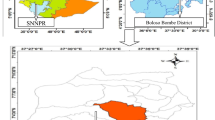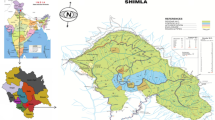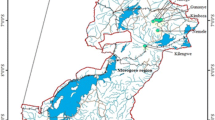Abstract
Topography is the most factor that has the greatest impact of all factor that affect the distribution. To study the diversity of trees and shrub species in the Perc forest situated in Khorramabad, Lorestan, 140 circular plots of 1200 m2 in a grid of 300 m × 250 m were surveyed, using a systematic random sampling method. In each plot, the Margalef richness index, Shannon–Wiener diversity index, Hill’s N 1 and Simpson indices and the evenness index of Simpson and Smith-Wilson were calculated and ordered on the basis of different classes of elevation, exposition and slope. The results indicated that slope did not have any significant effect on the indices. Exposition and elevation classes significant impacted the richness and diversity indices, but did not influence evenness. In general, the highest plant diversity was observed for slopes less than 15 %, northern aspects, without geographical direction, and elevations of 2100–2200 m. This information can be very useful in achieving the goals for sustainable management of forests. In addition to greater protection for regions with high diversity and reforestation (compatible species) in degraded area, we can help increase diversity in forests.

Similar content being viewed by others
References
Anonymous. 2003. Forest planing booklet. Forestry Department, Lorestan University
Bazyar M, Haidari M, Shabanian N, Hossein Heydari R (2013) Impact of physiographical factors on the plant species diversity in the Northern Zagros Forest (Case study: Kurdistan Province, Marivan region). Ann Biol 4(1):317–324
Burely J (2002) Forest biological diversity: an overview. Unasylva 53(209):3–9
Fattahi M (1994) A study of oak forest of Zagros and it’s important destructive factors. Research Institute of Forests and ranges, Sanandaj
Fu BJ, Liu SL, Ma KM, Zhu YG (2004) Relationships between soil characteristics, topography and plant diversity in a heterogeneous deciduous broad-leaved forest near Beijing, China. Plant Soil 261:47–54
Hashemi SA, Babaei Kafaki S (2009) Evaluation biodiversity in relation to physiographical factors in mountain forest in Iran. WSEAS Trans Environ Dev 12(5):738–748
Hatemi K, Attar-roshan S, Heydari M (2010) A study of species richness and plant life forms along altitudinal gradient in the rangelands of western Iran (case study: protected region of Arghavan, Ilam province). Iran J Sci Technol Nat Resour 5(4):99–111
Krebs JC (1998) Ecological methodology. Addison Wesley Longman Inc., Menlo Park
Mahmoudi J (2007) The study of species diversity in plant ecological groups in kelarabad protected forest. J Biol 20(4):353–362
Myers JA, Harms KE (2009) Seed arrival, ecological filters, and plant species richness: a meta-analysis. Ecol Lett 12(11):1250–1260
Parma R, Jouybari SS (2010) Impact of physiographic and human factors on crown cover and diversity of woody species in the Zagros forests (Case study: Ghalajeh forests, Kermanshah province). Iran J For Poplar Res 18(4):539–555
Pourbabaei H, Haghgooy T (2012) Plant species diversity in the ecological species groups in the Kandelat Forest Park, Guilan, Iran. Biodiversitas 13(1):7–12
Pourbabaei H, Haghgooy T (2013) Effect of physiographical factors on tree species diversity (case study: Kandelat Forest Park). Iran J For Poplar Res 21(2):243–255
Razavi SA, Rahmani R, Sattarian A (2009) The Investigation of Effective Factors on Biodiversity Using MLR (Case study; Vaz Research Forest). J Wood For Sci Technol 16(1):33–50
Sharifi M, Ghafori M (2008) Fundamental of ecology and environmental issues. Jihad University of Mashad Publications, Mashhad
Sohrabi H, Akbarinia M (2005) A study of plant diversity in relation to physiographic factors in dehsorkh forest, javanrod, Kermanshah province. Iran J For Poplar Res 13(3):279–294
Taleshi H, Akbarinia M (2011) Biodiversity of woody and herbaceous vegetation species in relation to environmental factors in lowland forests of eastern Nowshahr. J Biol 24(5):766–777
Author information
Authors and Affiliations
Corresponding author
Additional information
The online version is available at http://www.springerlink.com
Corresponding editor: Yu Lei
Rights and permissions
About this article
Cite this article
Hosseinzadeh, R., Soosani, J., Alijani, V. et al. Diversity of woody plant species and their relationship to physiographic factors in central Zagros forests (Case study: Perc forest, Khorramabad, Iran). J. For. Res. 27, 1137–1141 (2016). https://doi.org/10.1007/s11676-016-0243-0
Received:
Accepted:
Published:
Issue Date:
DOI: https://doi.org/10.1007/s11676-016-0243-0




